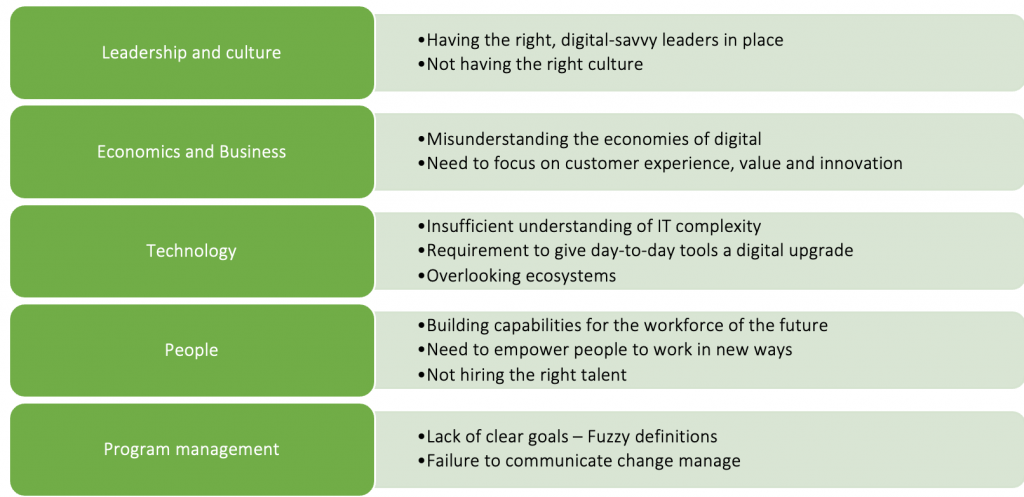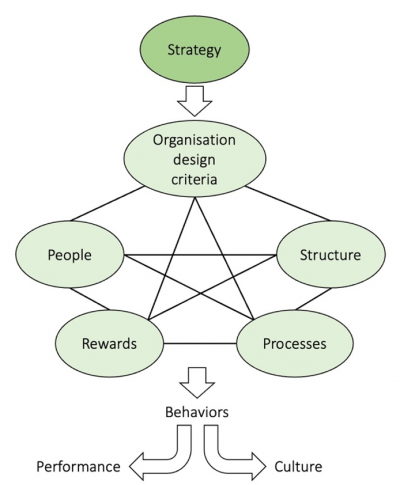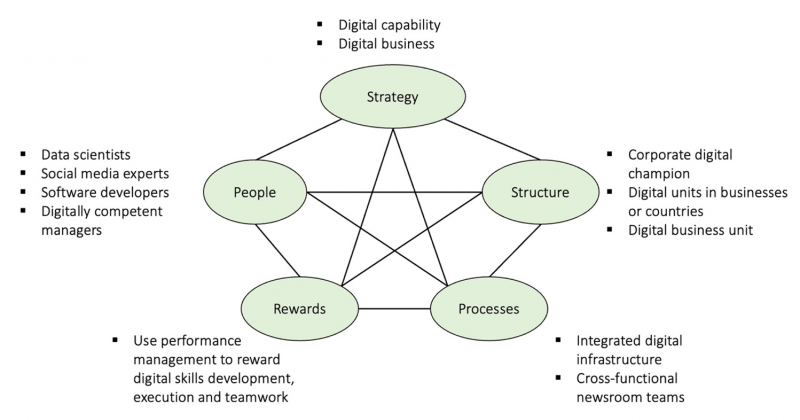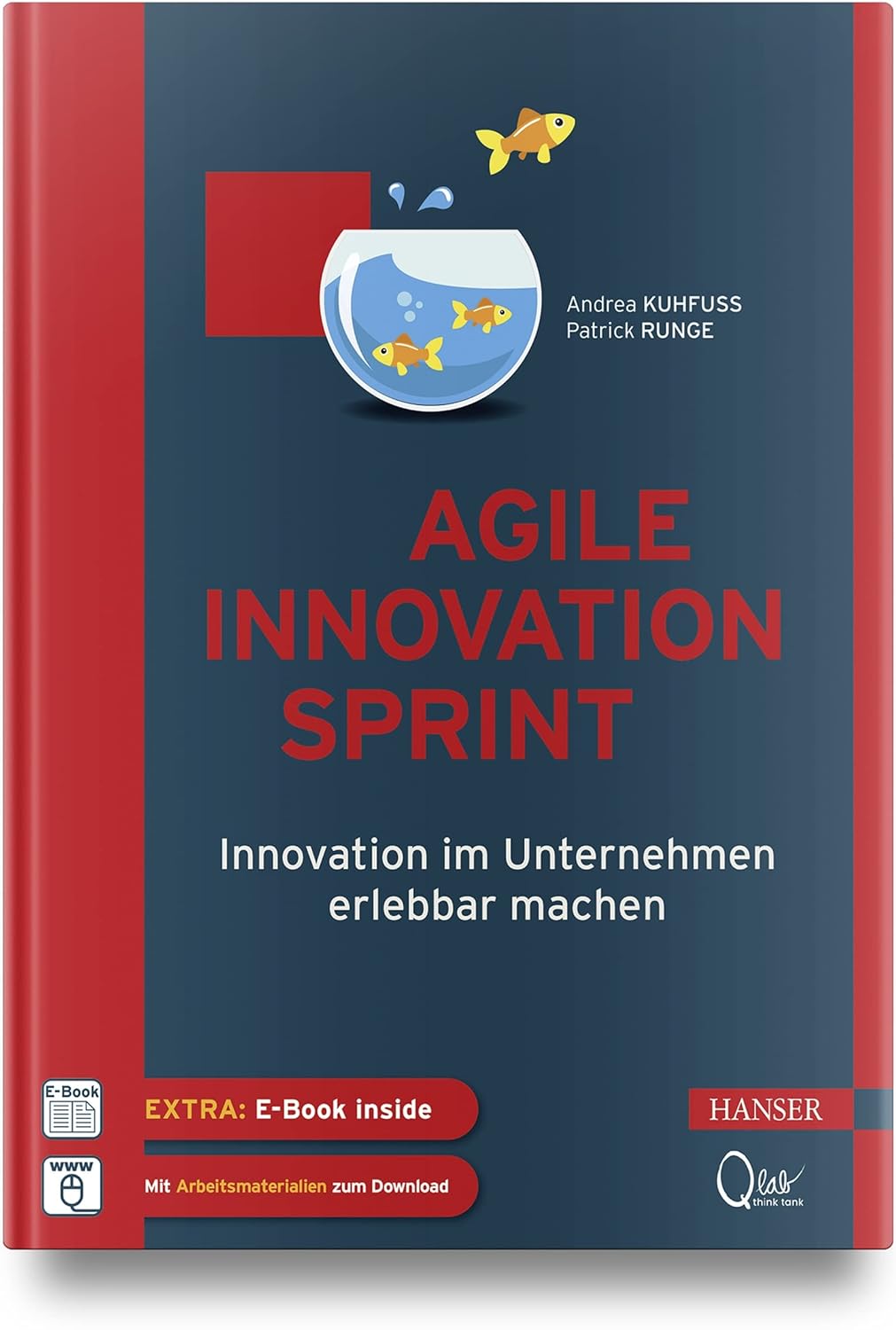by Brian Stewart (University of Alberta) and Anshuman Khare (Athabasca University)
Introduction
The generally accepted industry understanding of digital transformation is that it is a process and culture driven initiative with the objective of re-architecting the organization through innovative uses of technology. The focus being on substituting technology for labour by way of lean user focused process designs to improve operational efficiencies, customer experiences and develop new products and services. The need to accompany these shifts with supportive organizational change management to effect cultural receptivity is generally recognized. However, the need for supportive organizational redesign has generally been occluded and therefore has received less attention.
An organization’s structure reflects its business model and the strategy it has adopted to achieve its vision and objectives. For digital transformation to be successful, it will require a digital shift or elimination of workloads that have systemic effects on the pre-existing operating structures. To accommodate and sustain these impacts requires the operating model to be reformulated to reflect the desired future state. Thus, a more comprehensive change to the business is needed, one where digital technology Is a synergistic partner rather than a dominant one.
The literature on successful digital transformation focuses on motivation, culture, and transformation program organization. In general, the literature on successful DX or the reason for failure coalesces around five main areas as shown in Figure 1 based on research of Davenport & Westerman (2018); Westerman, Bonnet & McAfee (2014) and Sutcliff, Narsalay & Sen (2019).
A key element not generally mentioned is the relationship of organizational design to the goals of the transformation, in particular the systemic scope of any given transformation to the organizational structure. The need to revise the organization to fit with the post-transformed strategy is a critical element that increases the probability of both initial and sustained success. As posed below in the star model a given organizational structure reflects a best effort to organize activities to achieve the organizational strategy encompassing its distribution and grouping of resources, information flows, power relationships and delegation of decision rights and the process and technology used, all of which will need to be addressed for a successful transformation. The problem in digital transformation, is not how but how much!
What is Organisational Design?
Organisational design is the process of aligning the structure of an organisation with its objectives, with the ultimate aim of improving efficiency and effectiveness. Work can be triggered by the need to improve service delivery or specific business processes, or as a result of a new mandate.
According to the University of Southampton (2021), more than designing a structure, it involves:
- Understanding the imperative for change and the environment
- Understanding the business processes, workflows, roles and responsibilities, volumes of work, activity analysis and resources
- Designing and testing new models or structures
- Planning and managing the transition from the old structure to the new
- Implementing and monitoring the change
Star Model
A relevant example of organizational design is the Galbraith’s star model (Figure 2).
In the Star Model™, design policies fall into five categories.
- Strategy, which determines direction
- Structure, which determines the location of decision-making power
- Processes, which have to do with the flow of information; they are the means of responding to information technologies
- Rewards and reward systems, which influence the motivation of people to perform and address organizational goals
- Policies relating to people (human resource policies), which influence and frequently define the employees’ mind-sets and skills.
The Star Model™ consists of policies that leaders can control and that can affect employee behavior, as suggested in the diagram. It shows that managers can influence performance and culture, but only by acting through the design policies that affect behavior.
Another insight to be gained from the Star Model™ is that different strategies lead to different organizations. Although this seems obvious, it has ramifications that are often overlooked. There is no one-size-fits-all organization design that all companies–regardless of their particular strategy needs–should subscribe to. All designs have merit but not for all companies in all circumstances. As the layout of the Star Model™ illustrates, structure is only one facet of an organization’s designs, that should be chosen is the one that best meets the criteria derived from the strategy.
A third implication of the Star Model™ is in the interweaving nature of the lines that form the star shape. For an organization to be effective, all the policies must be aligned and interacting harmoniously with one another. An alignment of all the policies will communicate a clear, consistent message to the company’s employees.
Applying the Star model to DX
Galbraith applied big data to an organization using his star model to use big data to improve decision making and performance and to become a source of revenue. A strategy very much within the canon of Digital transformation. He identified that in order to implement the strategic change necessary the company would need to change their organization.
The adaption to the original model (see Figure 3) shows the revisions necessary to the five component areas. Three of these are generally referred to in the DX literature, strategy, people and processes, whereas rewards and structure claim little if any attention outside the direct project initiative team structure. In the data analytics example, there will need to be a digital lead to promote data as a strategic asset that can help grow the company and make it more successful. In addition, each business unit will need a digital unit to support its activities. Those digital units will report to both their respective profit center heads and the Chief Digital Officer. Such structural changes will constitute a shift in power to the digital units, and the company will need to rebalance its power structure and prepare for faster decision making. Finally, there will be a digital business unit or units that will earn revenue and become a profit center. The aspiring big data company will also need to create information and decision processes to support the structure and strategy.
As most organizations are organized by either function or division, commonly referred to as the U or M designs, or a hybrid of both. They have organizational specialties prearranged around the value chain to create the final output required by the function. A fourth structural type matrix involves having resources simultaneously reporting to more than one entity and are generally used for project structures.
The current DX literature does much to discuss the impacts of digitalization and how companies can improve functional performance, it has been less forthcoming on the deeper organizational impacts that accompany these “transformations”. It can be seen as one of the reasons why digital transformations fail – as, in the main initiatives, are not approaching the change from a transformative perspective but rather from that of performance improvement. The transformation goals are therefore not aligned with the overall change program objectives and the degree of substantive change required is not undertaken.
Role of Leadership
The burden to address this broadening of scope to include not only cultural change but also organisational redesign ultimately falls on leadership. The greater the degree of change the more effort leadership will need to expend. A critical component of this will be leadership’s understanding, acceptance and demonstration of the new model. This will likely be at a level lower than was formerly required for the old model. Leadership did not need to justify the old model, the organization’s traditions validated it. To change the accepted way, requires constant reinforcement and justification until the new way become seen as better and is self-justified. This is a very difficult challenge as it disrupts relationships and political alliances that all organisations exhibit. Indeed, it is more likely the case that the leading coalition initiating a DX will itself be disrupted by an organisational redesign. This may be a step too far for many organisations and possibly explains why green site firms are better positioned to adopt digital technologies to a far deeper extent into their businesses than pre-existing counterparts.
Conclusion
When considering Org design and DX the tendency is to view how DX needs to be best structured within the organization to achieve its transformative activities. This, rather than how the organization as a whole needs to look after it has been transformed. In essence it is function specific.
The organizational redesign will prove to be an iterative process as it follows from the nature of a transformation which will be a series of initiatives that can only be fully understood after completion. Nonetheless they can both can be broken into horizons analogous to software design sprints that allow progress to be made and registered in completed sections and built on as knowledge grows.
The current focus tends to be on strategy, the business model and operating model, with some attention given to leadership and the corporate culture. This significantly understates the importance of the structure on the behavior of individuals and if a key success factor of digital transformation is to digitize activities that requires the incorporation of digital ways of working into behaviours, the way people are managed, the jobs they are hired to, their accountabilities and their career path will have an equal or more impact on their willingness and ability to adapt. Incentives matter and organisational structure reinforces incentives.
References
Davenport, T. H. & Westerman, G. (2018). Why so many high-profile digital transformations fail. Harvard Business Review, 9, 15.
Galbraith, J. R. (2011). The star model. The STAR Model. Available http://www.jaygalbraith.com/images/pdfs/StarModel.pdf
Sutcliff, M., Narsalay, R. & Sen, A. (2019). The Two Big Reasons That Digital Transformations Fail. Harvard Business Review.
University of Southampton (2021). Organisational Development & Design Explained. Human Resources. Russell Group. Available https://www.southampton.ac.uk/hr/services/od-explained/index.page
Westerman, G., Bonnet, D. & McAfee, A. (2014). Leading digital: Turning technology into business transformation. Harvard Business Press.
All rights and responsibilities for this article are with the authors, who provided the article for the xm-institute blog.
 Brian Steward (more)
Brian Steward (more)
 Anshuman Khare (more)
Anshuman Khare (more)










Leave A Comment